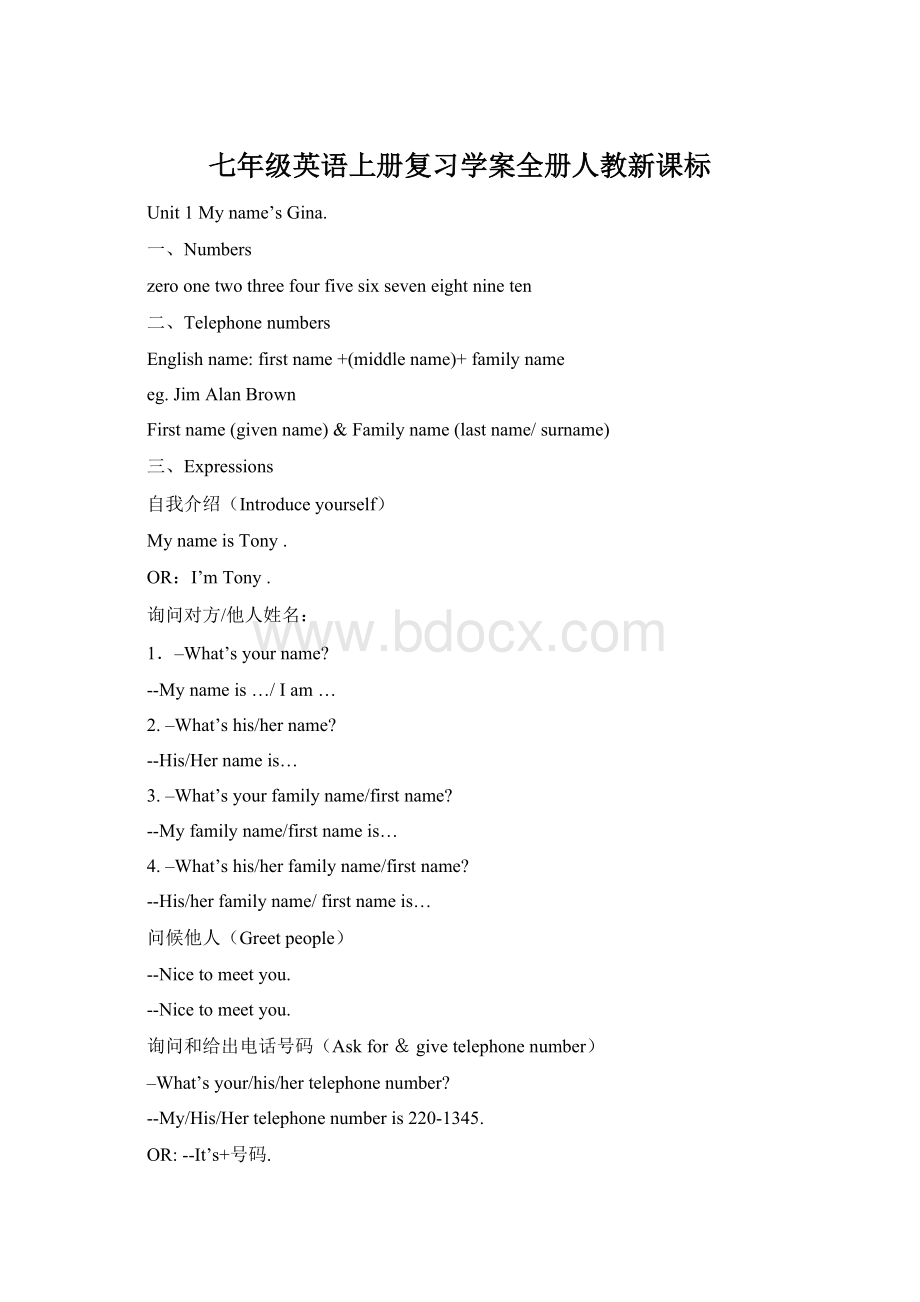七年级英语上册复习学案全册人教新课标.docx
《七年级英语上册复习学案全册人教新课标.docx》由会员分享,可在线阅读,更多相关《七年级英语上册复习学案全册人教新课标.docx(13页珍藏版)》请在冰豆网上搜索。

七年级英语上册复习学案全册人教新课标
Unit1Myname’sGina.
一、Numbers
zeroonetwothreefourfivesixseveneightnineten
二、Telephonenumbers
Englishname:
firstname+(middlename)+familyname
eg.JimAlanBrown
Firstname(givenname)&Familyname(lastname/surname)
三、Expressions
自我介绍(Introduceyourself)
MynameisTony.
OR:
I’mTony.
询问对方/他人姓名:
1.–What’syourname?
--Mynameis…/Iam…
2.–What’shis/hername?
--His/Hernameis…
3.–What’syourfamilyname/firstname?
--Myfamilyname/firstnameis…
4.–What’shis/herfamilyname/firstname?
--His/herfamilyname/firstnameis…
问候他人(Greetpeople)
--Nicetomeetyou.
--Nicetomeetyou.
询问和给出电话号码(Askfor&givetelephonenumber)
–What’syour/his/hertelephonenumber?
--My/His/Hertelephonenumberis220-1345.
OR:
--It’s+号码.
四、Grammar
1、be(is\am\are)动词用法:
口诀:
I用am,you用are,is用于她他它(she\he\it)
单数形式用is,复数形式要用are.
Eg.Iamastudent.
Youaremyteacher.
Sheisagirl.Heisaboy.Itisapen
Whatisyourname?
Myphonenumberis220-1234.
2、本单元出现的形容词性物主代词(Pronounsforownership)
my/your/his/her均为形容词性物主代词,其后面必须跟上用于表示“人”或“物”的名词。
eg:
my/your/his/herbackpack/book/baseball/rulers/clocks
my/your/his/herfather/mother/cousin/parents/friends
UNIT2Isthisyourpencil?
一、确认物主关系(Identifyownership)
--Isthis/thatyourbackpack?
(单数)
--Yes,itis.It’smybackpack./
--No,itisn’t.It’shisbackpack.
二、指明物主关系(Pointoutownership)
--This/Thatis(not)hisbaseball.(单数)
三、失物招领(Lost&found)
1、招领启事
2、寻物启事
四、Expression
--What’sthis\thatinEnglish?
--It’sa\an….
--Howdoyouspellit?
(Spellit,please.)
(Canyouspellit?
)
--P-E-N.(P-E-N.)
(Yes,P-E-N.)
五、知识点(Languagepoints)
1、lost&found(case)失物招领(箱)
inthelost&foundcase在失物招领箱里
2、schoolIDcard学生证
3、callsb.at7320567拨打电话7320567找某人/
打电话找某人,电话号码是7320567
4、asetofkeys一串钥匙
5、inEnglish用英语
Unit3Thisismysister
一、家庭成员
1、father/mother(parent)father&mother(parents)
2、grandfather(grandpa)/grandmother(grandma)=grandparent
grandfather&grandmother=grandparents
3、uncle/auntbrother/sister/cousinson/daughter
4、grandson/granddaughter
二、thisthesethatthose的用法
近处
远处
Be动词
单数
this
that
is
复数
these
those
are
Thisisabook.Thatisacar.
Thesearebooks.Thosearecars.
三、人称代词、物主代词
he-hisshe-herit-itsthey-theirI-mywe-ouryou-your
Wearestudents.Thisisourclassroom.
HeisanewstudentHisnameisTom.
四、单数和复数(注意一致性)
Eg.Thisismybook.Thesearemybooks.
Thatisherfriend.Thoseareherfriends.
名词单数变复数的方法
一般在名词后+Srulerrulers
以sshchx等结尾+esbusbuseswatchwatches
以辅音字母+y结尾改Y为I+esstudystudies
以O结尾+S或es(奇数+S偶数+es)zoostomatoes
单、复数的形式一样sheep
不规则manmenwomanwomenchildchildren
五、介绍他人,确认人物
介绍他人
1、This/Thatis(not)mysister/hisbrother/Tom.
2、These/Thoseare(not)herparents/friends.
确认人物
1、--Isthis/thatyourfather?
--Yes,itis./No,itisn’t.
2、--Arethese/thoseJim’sfriends?
--Yes,theyare./No,theyaren’t.
3、--Ishe/sheyourbrother/sister?
--Yes,he/sheis./No,he/sheisn’t.
4、--Aretheyyoursister’sfriends?
--Yes,theyare./No,theyaren’t.
六、短信的格式
七、知识点
1、thankyoufor…=thanksfor…谢谢你的…
eg:
Thankyouforyourhelp/yourpen.
谢谢你的帮助/钢笔.
2、thephoto/pictureofyourfamily
你的全家福/全家人的照片
myfamilyphoto我的全家福/全家人的照片
3、apictureofJim一张吉姆的照片(照片上是吉姆)
Jim’spicture吉姆的一张照片(不是别人的)
Unit4Where’smybackpack?
一重点词汇:
table,bed,dresser,bookcase,drawer,sofa,chair,
CD,plant,alarmclock,mathbook,videotape,hat,ect
二、表示地点或位置的介词
1in:
大家好!
我是介词in,我性格内向,非常害羞,总爱躲在某个物体的里面
2on:
Hi,everyone!
我是介词on,我最喜欢和某一物体的表面“亲密接触”。
3under:
Hello!
我是介词on的弟弟under,我常与on唱反调,喜欢待在某物的下面。
[拓展]
4behind表示“在......后面”,常指一个物体在另一个物体的后面。
5nextto紧挨着;在......旁边:
与......邻接
6between表示“在两者之间”,通常与and连用
7near表示“在......附近”
三、重要句型、语法
询问位置
1、--Whereisyourpencil?
--It’sonthedesk/inthebackpack/underthechair.
2、--Wherearemybooks?
--They’reinthedrawer/onthedresser.
指明位置
1、Thebasketballis(not)underthetable.
Herskirtis(not)onthebed.
2、Thekeysare(not)inthedrawer.
Myshoesare(not)underthebed.
确认位置
1、--Ishiseraserinthepencilcase?
--Yes,itis./No,itisn’t.
2、--Arehersocksinthebag?
--Yes,theyare./No,theyaren’t.
(whereis=where’s,where与are不缩写)
Eg:
(1)Where’smybackpack?
It’sunderthetable.
(2)Whereareyourbooks?
They’reonthesofa.
(3)Whereisthecomputergame?
It’sunderthebed.
(4)Wherearehis/herkeys?
They’reinthedrawer.
(5)A:
Where’sthealarmclock?
B:
Idon’tknow.Isitonthedresser?
A:
Yes,itis./NO,itisn’t.
2辨析
(1)desk与table二者都有“桌子”之意,但desk指供读书、写字、办公用的桌子,一般带抽屉;table侧重于指吃饭、喝茶或其他用途的桌子,通常没有抽屉。
(2)onthebed与inbed二者都有“在床上”之意,但onthebed指东西在床上;inbed指卧床/睡在床上。
(2)take…to…与bring…to…二者都有“带走”,“拿走”之意,但take指从这里把某人或某物带走、拿走;而bring指从别处把某人或某物带走、拿走。
3情态动词can
(1)表示能力“会,能”
eg:
--Canyou/he/she/theyplaytennis?
--Yes,I/he/she/theycan.
No,I/he/she/theycan’t.
(2)表示有礼貌地征询对方意见或许可“你能…吗?
”
eg:
--Canyoubringsomethingstoschool?
--Sure/Certainly/Ofcourse.(肯定回答)
Sorry,Ican’t.(婉言拒绝)
Unit5Doyouhaveasoccerball?
体育器材大比拼。
1.abaseball2.abaseballbat3.afootball
4.atennisball5.atennisracket6.abasketball
7.aping-pongball8.aping-pongbat9.asoccerball
10.avolleyball
二、重点词汇。
1.playbaseball/football/tennis/basketball/ping-pong/soccer/volleyball
2.have/has3.do/does4.let’s=letus
5.soundgood/interesting/fun/difficult/boring/relaxing6.donot=don’t
7.doesnot=doesn’t8.haveagreat/smallsportscollection
9.watchTV10.everyday11.only
12.but13.playsports14.sportsclub
三、重点句子。
1.DoyouhaveaTV?
Yes,Ido.IhaveaTV.
NO,Idon't.Idon’thaveaTV.
2.Dotheyhaveacomputer?
Yes,theydo.Theyhaveacomputer.
No,theydon't.Theydon’thaveacomputer
3.Doeshe/shehaveatennisracket?
Yes,he/shedoes.He/Shehasatennisracket.
No,he/shedoesn't.He/Shedoesn’thaveatennisracket
4.Let'splaysoccer.
Thatsoundsgood/interesting/fun/difficult/boring/relaxing.
5.Ihaveagreatsportscollection.
Ihave8basketballs,2baseballsand3volleyballs.
She/Hehasasportscollection.
四、语法讲解。
1.用have对物品的所属进行提问以及应答,使用do和does引导的一般疑问句。
(见重点句子1至3)
2.用祈使句型Let’s…提建议,谈论自己喜欢哪些球类运动,不喜欢哪些球类运动。
(见重点句子第4)
3.学会名词复数的使用。
(见重点句子第5)
4.运用所学的知识谈论自己或他人的拥有,进行适当的阅读和写作练习。
(见重点句子第5)
Unit6Doyoulikebananas?
一词汇
1.Countablenoun:
hamburgertomatobananastrawberryeggcarrotapplechickenvegetablepear
2.Uncountablenoun:
broccolibreakfastlunchdinner
3.Countablenounanduncountablenoun:
orangeicecreamsaladfruit
Frenchfries(pl)
二句型
1.Doyoulikesalad?
Yes,Ido.Ilikesalad.
No,Idon't.Idon’tlikesalad.
2.DotheylikeFrenchfries?
Yes,theydo.TheylikeFrenchfries.
No,theydon't.Theydon’tlikeFrenchfries.
3.Doeshe/shelikepears?
Yes,he/shedoes.He/Shelikespears.
No,he/shedoesn't.He/Shedoesn’tlikepears.
4.Theylikesalad.Theydon'tlikesalad.
5.She/Helikesbananas.
6.She/Hedoesn'tlikebananas.
7.IlikeorangesbutIdon'tlikeapples.
8.Ilikeoranges.Idon'tlikeoranges.
9.Forbreakfast,Tomlikeseggs,bananasandapples.
Forlunch,hehashamburgers,saladandpears.
Andfordinner,helikeschicken,tomatoesandbroccoli.
10、----Whatdoyoulikemost?
----Ilikeicecreamandcarrots.
11、----Whatdoyoulikeforbreakfast?
----Ilikebreadandmilk.
12、-----Whatdoeshe/shelikeforlunch?
-----He/Shelikesbroccoliandtomatoesforlunch.
三语法
1、一般现在时
一般现在时主要表示经常性或习惯性的动作、现在的特征或状态以及普遍真理。
例如:
WhenIcomeacrossanewwordIconsulttheEnglishdictionary.每当我遇到一个新词时,我就查字典。
TomlivesinEngland.汤姆住在英国。
Helikestoread.他喜欢看书。
Lighttravelsfasterthansound.光速比音速快。
一般现在时的否定式和疑问式都需要用助动词do和does。
do用在第一人称、第二人称、第三人称复数和其他的复数名词前,does用在第三人称单数前,无实在意义。
如:
DoesTomliveinEngland?
汤姆住在英国吗?
Yes,hedoes.是的。
Dotheyliketogohiking?
他们喜欢远足吗?
No,theydon’t.不,他们不喜欢。
2、单词like
(1)介词be/looklike像,看起来像
Sheis/lookslikehermother.
(2)动词likesth/liketodosth/likedoingsth
Ilikeapples.
Shedoesn'tliketobelate.
Helikesplayingsoccer.
特别注意:
1.在一般现在时中,当主语是第三人称单数时,其肯定句的谓语由动词原形+s(es)构成。
否定句的谓语由doesn’t+动词原形构成。
一般疑问句句首用Does,句中的谓语用动词原形充当。
当主语是第一、二人称单复数和第三人称复数时,肯定句的谓语由动词原形充当。
否定句的谓语由don’t+动词原形构成。
一般疑问句句首用Do,句中的谓语用动词原形。
2.主语第三人称单数:
he,she,it,myfather,yoursister,Tom等等。
四、词组
1、healthyfood2、goonapicnic3、makealistoffood4、lotsof/alotof5、howmany/howmuch
Unit7Howmucharethepants?
一、重点句型
问价格
1.HowmuchisthisT-shirt?
It’s10dollars.
2.Howmucharethey?
Theyare100dollars.
3.Howmuchistheredsweater?
It’seightdollars.
4.Howmuchisthisblueskirt?
It’ssevendollars.
5Howmuchisthatwhitebag?
It’sninedollars.
6.Howmucharetheseblackpants?
They’retendollars.
7.Howmucharethosebluesocks?
They’rethreedollars.
问颜色Whatcolordoyouwant?
Whatcolorisit?
二、购物用语:
1.CanIhelpyou?
/WhatcanIdoforyou?
Yes,please./No,thanks.
2.That’stooexpensive!
3.That’sfine,I’lltakeit.
4.Thankyou.
5.You’rewelcome.=That’sallright.
Importantwordsandexpressions
clothes:
pantsshortssocksshirtT-shirtskirtsweatershoes
clothes,pants.shorts,socksshoes一般情况下用,复数形式.
例如:
Howmucharethepants?
Howmucharetheshoes?
Howmucharetheshorts?
Howmucharethesocks?
somecolors:
redgreenblackwhiteblueyellow
pinkpurplegrayorange
big~~small(大,小)short~~long(短,长)tall~~short(高,矮)
三、基数词fromthirteentonineteen~~~~~thirteenfourteenfifteensixteenseventeeneighteennineteen.二十(twenty)三十(thirty)
onsale出售
Manythingsareonsaleinthisshop.这家商店有很多东西出售.
Thathatisonsaleforsevendollars那顶帽子售价七美元
atagoodprice
havealookat…
bagsforsports